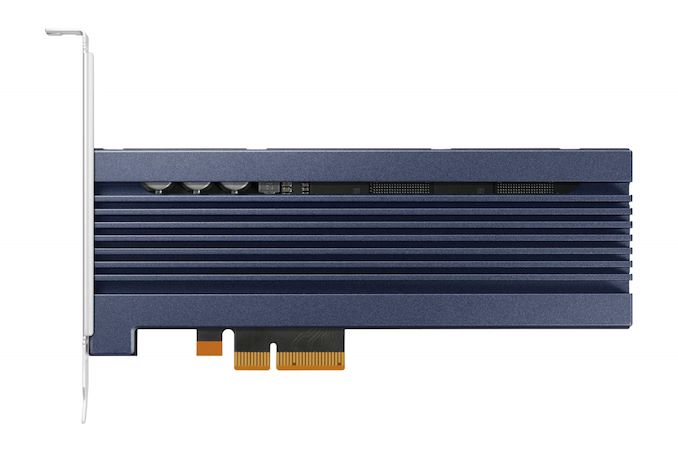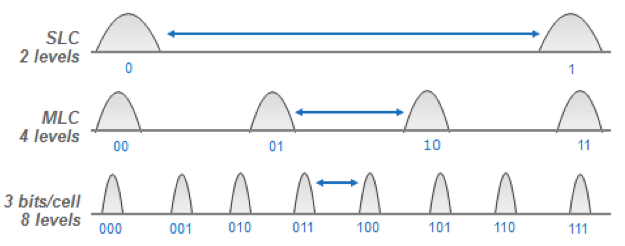The Samsung 983 ZET (Z-NAND) SSD Review: How Fast Can Flash Memory Get?
by Billy Tallis on February 19, 2019 8:00 AM EST
In 2015, Intel and Micron unveiled 3D XPoint memory, a new competitor to flash memory that promised significantly higher performance and endurance. Several years later, Intel has successfully commercialized 3D XPoint memory in a growing range of Optane products, but other alternative non-volatile memory technologies are still largely stuck in the lab.
To compete against Intel's Optane SSDs, Samsung decided to exercise their lead in 3D NAND flash memory to produce a specialized high-performance variant, which they call Z-NAND. Fittingly, the first SSDs they use it in are branded "Z-SSDs". The first two models to be released were the SZ983 and SZ985, which were both high-end drives specifically for datacenter customers.
Meanwhile, with their major datacenter customers taken care of, Samsung is moving to make more of their enterprise and datacenter storage products available through retail distribution channels instead of just large-volume B2B sales. Spearheading that initiative, the SZ983 is now being sold to retail customers as the Samsung 983 ZET.
Enter the 983 ZET: Going Back To SLC
Samsung originally announced Z-NAND in 2016, a year after 3D XPoint memory was announced and before any Optane products had shipped. Fundamentally, the first generation of Z-NAND is an effort to turn back the clock a bit; to step back from today's modern, high-density, (relatively) high-latency Triple Level Cell (TLC) NAND and back to simpler Single Level Cell (SLC) designs.
SLC designs are relatively straightforward: since they only need to store a single bit of data per cell, the cell only needs to be in one of two voltage states. And this makes them both faster to read and faster to write – sometimes immensely so. The tradeoff is that they offer less density per cell – one-half or one-third as much data as the equivalent MLC or TLC NAND – and therefore a higher cost per bit overall. This has lead to the rapid adoption of MLC and then TLC, which for most use cases is plenty sufficient in terms of performance while also offering great capacity.
However there are markets and use cases where absolute speed (and not capacity) is king, and this is where a SLC-based storage solution can provide much better real-world performance; enough so to justify the higher per-bit cost. And it's this market that Intel and Samsung have been exploiting with their 3D XPoint and Z-NAND products respectively.
Adding an extra wrinkle to all of this is that Samsung's Z-NAND isn't merely SLC NAND; if simply operating existing NAND as SLC was all there is to Z-NAND, then we would also expect Toshiba, WD, SK Hynix to have also delivered their competitors by now. Instead, Samsung has taken additional steps to further improve their SLC-based Z-NAND. We'll go into greater detail on this on the next page, but one of the big changes here was lowering the read and program times of the NAND, which further improves its read/write performance. This is important for Samsung both to give them an edge over the aforementioned competition, but also to ensure Z-NAND is competitive with 3D XPoint, which has proven to be no slouch in this area.
On paper then, Samsung's Z-NAND looks plenty fast for the kinds of workloads and markets Samsung is chasing. Now it comes to Samsung's 983 ZET to deliver on those ambitions.
| Samsung 983 ZET Specifications | |||
| Capacity | 480 GB | 960 GB | |
| Controller | Samsung Phoenix | ||
| Form Factor | HHHL PCIe AIC | ||
| Interface, Protocol | PCIe 3.0 x4 NVMe 1.2b | ||
| NAND Flash | Samsung 64Gb 48L SLC Z-NAND | ||
| Sequential Read | 3400 MB/s | ||
| Sequential Write | 3000 MB/s | ||
| 4kB Random Read | QD32 Throughput | 750k IOPS | |
| QD1 99.99% Latency | 30 µs | ||
| 4kB Random Write | QD32 Throughput | 60k IOPS | 75k IOPS |
| QD1 99.99% Latency | 30 µs | ||
| Power Consumption | Read | 8.5 W | |
| Write | 9.0 W | ||
| Idle | 5.5 W | ||
| Write Endurance Drive Writes Per Day |
7.4 PB 8.5 DWPD |
17.5 PB 10 DWPD |
|
| Warranty | 5 years | ||
| Price | $999.99 ($2.08/GB) | $2075.85 ($2.16/GB) | |
The Samsung 983 ZET uses the same Phoenix controller that we are familiar with from their TLC-based 983 DCT and the 970 family of consumer NVMe SSDs. Eight channels makes for a high-end controller in the consumer market, but this is more of an entry-level controller in the datacenter space—the other flash-based SSDs we're comparing against have more powerful 12 or 16 channel controllers.
The 983 ZET is available in just two capacities, both using a PCIe add-in card form factor. Samsung has demonstrated a M.2 Z-SSD and this controller is used in several other M.2 and U.2 drives, but the Z-SSDs are a relatively low-volume product and this retail channel version is even more of a niche product, so the limited range of SKUs makes sense.
The sequential read and write specs for the 983 ZET are typical for high-end NVMe drives with PCIe 3 x4 interfaces, but it's uncommon to see these speeds at such low capacities: the small per-die capacity of Samsung's Z-NAND gives the 480GB 983 DCT as much parallelism to work with as a 2TB TLC drive. The random read performance of 750k IOPS is impressive for a SSD of any capacity, and while it isn't entirely unprecedented, it is significantly higher than the 550k IOPS that Intel's Optane SSD DC P4800X is rated for.
The random write specs bring the first difference in performance between the two capacities of the 983 ZET, and a stark reminder that we're still dealing with some of the limitations of flash memory. The steady-state random write performance is just 60k to 75k IOPS, an order of magnitude lower than the random read performance. Intel's Optane SSDs are only slightly slower for random writes than random reads, so the 983 ZET won't be able to come close to matching Optane performance on workloads that include a significant quantity of random writes.
Write endurance for the 983 ZET also falls short of the bar set by Intel's Optane SSDs, with 8.5 DWPD for the 480GB 983 ZET and 10 DWPD for the 960 GB model, while the Optane SSD debuted with a 30 DWPD rating that has since been increased to 60 DWPD.
The Competition
This review builds on our recent roundup of enterprise SSDs, and follows the same format and test procedures. This review is strictly focused on the use of the 983 ZET as a datacenter SSD, but we will have a follow-up to assess its suitability as an enthusiast class workstation/consumer drive.
Our collection of enterprise and datacenter SSDs is much smaller than our almost comprehensive catalog of consumer SSDs, but we do have drives from several different market segments to compare against. Most of these drives were described in detail in our last enterprise SSD review. The most important competitor is obviously the Intel Optane SSD DC P4800X, Intel's flagship and the drive that Samsung's Z-SSDs were created to compete against.
Sadly unavailable for this review is the Micron P320h, an early PCIe SSD that used 34nm planar SLC NAND and advertised similar random read performance, and better random write performance and endurance. The controller was a 32-channel monster with a PCIe 2.0 x8 host interface that used a proprietary protocol rather than the nascent NVMHCI standard that we now know as NVMe. That controller product line passed from IDT to PMC-Sierra to Microsemi and now Microchip, and its descendants are used in two other drives included in this review, both of which use the 16-channel versions rather than the 32-channel:
- The Micron 9100 MAX 2.4TB, based on 16nm MLC with excessive overprovisioning: a 4TB raw capacity but only 2.4TB usable.
-
The Memblaze PBlaze5 C900 and D900, both based on Micron 32L TLC NAND. We have a 6.4TB sample of the newer generation PBlaze5 with 64L TLC on the way for a future review.
















44 Comments
View All Comments
WithoutWeakness - Tuesday, February 19, 2019 - link
Hahaha I was hoping someone else would remember the absurdity of that comment thread. I thought of it as soon as I read that this drive was running SLC. Shame ddriver hasn't shown up here to provide his valuable insight and tell us what the engineers at Samsung did wrong and what they should have changed in order to beat Optane in mixed workloads.PaoDeTech - Tuesday, February 19, 2019 - link
Ovonic is the word.Fujikoma - Tuesday, February 19, 2019 - link
"The tradeoff is that they offer less density per cell – one-half or one-third".Should be one-quarter, not one-third... power of 2.
Billy Tallis - Tuesday, February 19, 2019 - link
TLC is three bits per cell, which is three times the density of SLC. The powers of two show up when you count the number of possible voltage levels that a cell may be programmed to, but that doesn't directly affect density, just endurance and the required amount of error correction.FunBunny2 - Wednesday, February 20, 2019 - link
"TLC is three bits per cell, which is three times the density of SLC. "but... is it still true that T and Q cells are being constructed on much larger nodes (layered) of 40 to 50 nm? or is there a move afoot to exploit nearer to current nodes in order to make more moolah?
and so far as density measures: how to do an apples to apples comparison SLC planar at 1x nm (could be done, but it isn't, right?) to 50 nm TLC layered? what about SLC 1x nm *layered*? might that not approach T and Q 50 nm layered? or is layered only possible are very large nodes with current machines? and so on.
ianken - Tuesday, February 19, 2019 - link
It's not for overclokerz gaemrz d00dz.ITT: overcloxoring gam3r d00dz bitching about the cost.
haukionkannel - Wednesday, February 20, 2019 - link
It seems that if you want to get speed, you just go for optane, or this should be much cheaper...cm2187 - Wednesday, February 20, 2019 - link
I can understand super fast SSDs for database cache and other industrial applications. But who would need such high performances in the retail space? Like what for?ballsystemlord - Wednesday, February 20, 2019 - link
Spelling and grammar corrections:Performance at such light loads is absolutely not what most of these drives are made for, but they have to make through the easy tests before we move on to the more realistic challenges.
Missing it:
Performance at such light loads is absolutely not what most of these drives are made for, but they have to make it through the easy tests before we move on to the more realistic challenges.
...incrementally reduce the rate until the test can run for a full hour, and the decrease the rate further if necessary to get the drive under the latency limits.
Should be "then" not "the":
...incrementally reduce the rate until the test can run for a full hour, and then decrease the rate further if necessary to get the drive under the latency limits.
I read the whole thing and found only 2 mistakes, good work!
MDD1963 - Friday, February 22, 2019 - link
I was expecting some numbers that looked at least impressive compared to a 970 EVO; seeing as the only significat number difference is the price at nearly triple EVOs price,.... I'll pass....(Someone wake me up when we start seeing 4,000 MB/sec reads....)